|
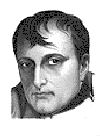
Napoleon Bonaparte
La Grand Armee
48,160 infantry
13,120 cavalry
104 artillery |
BATTLE OF PURKERSOORS
MAY 11,12, 1810
Campaign Blog
(Not for current players) |

Archduke Charles
Osterreichische Grossartige Armee
43,680 infantry
47,520 Landwehr infantry
6,400 cavalry
3,200 Landwehr cavalry
96 artillery |
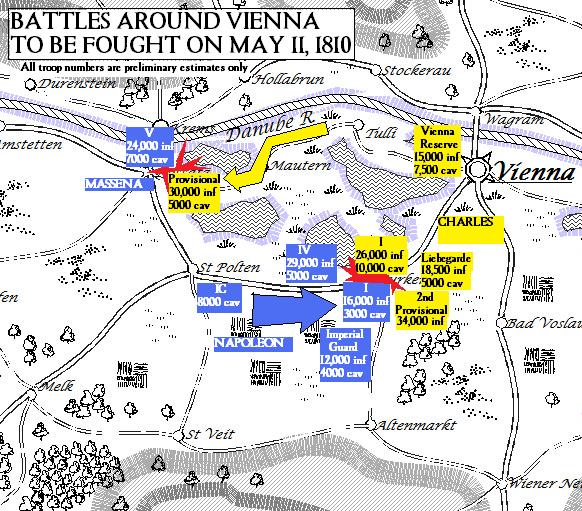 On May 9th, Napoleon drove back a tentative attack by Austrian 2nd Provisional
Korps at St Polten. On the 10th, the forefront of the army pressed forward to
Purkersoors, seeking to continue the impetus against the Austrian capital. After
40 days of campaigning, the French army is much reduced and the army that
marches out to meet them at Purkersoors is fresh and well-equipped. It is the
army that Charles has rapidly assembled after the surrender at Steyr.
Unfortunately for the Austrians, their haste in mustering this army has required
that the force be predominantly conscripts.
On May 9th, Napoleon drove back a tentative attack by Austrian 2nd Provisional
Korps at St Polten. On the 10th, the forefront of the army pressed forward to
Purkersoors, seeking to continue the impetus against the Austrian capital. After
40 days of campaigning, the French army is much reduced and the army that
marches out to meet them at Purkersoors is fresh and well-equipped. It is the
army that Charles has rapidly assembled after the surrender at Steyr.
Unfortunately for the Austrians, their haste in mustering this army has required
that the force be predominantly conscripts.
It is a Landwehr Corps that strikes at
Rossatz on the same day but Massena will be there with V Corps (and at Krems) so
the Austrian conscripts are thrown back with heavy losses.
The battle at Purkersoors though shapes up to be a critical
contest. Napoleon has proposed a peace treaty with the Coalition and he requires
a decisive victory here if he hopes for an end to the war. Anything else would
give too much hope to the coalition forces and the war would be extended.
Napoleon is keenly aware of how exhausted his army is and imagines a disaster if
he were to lose this battle with such extended lines of supply behind him.
For the Austrians, Archduke Charles knows that this may be a
last desperate opportunity to halt the French and to gain a victory that would
mean so much for coalition morale. It is true that the Austrian army is still
trying to assemble more forces near the capital but the politics of the treaty
loom over the war council.

The Austrians
would commence the battle with their Liebegarde (grenadiers and heavy cavalry)
placed as a reserve behind the Vienna woods. Even the 2nd Provisional Korps was
hidden from French view behind the screen of 1st Korps. Napoleon had anticipated
the deployment (though he had expected the Liebegarde to also be in the defile
between the woods). To the Austrians, this would be an attempt to protect the
Landwehr and force the French to attack a wall of artillery on a narrow front.
For Napoleon, this was an opportunity to emulate Friedland. By attacking
aggressively into 1st Korps, he could force the Austrians back onto their
reserves and have no option but to disorder those forces behind and crowd
together, making it impossible for the Austrians to manoeuvre.
The order that Napoleon would give initially
is that the Imperial Guard would secure the corner of the Vienna Wood that was
contested by Austrian light troops. I Corps would move behind the Guard to join
with IV Corps in engaging the Austrian artillery line. At a time to be
coordinated as the battle developed, the whole of the French army would
simultaneously coordinate an attack against the Austrian line and then attack
relentlessly to press them back. First though, cavalry and artillery still
needed to arrive from St Polten. A heavy rain hung over the battlefield
throughout the day, decreasing musket effectiveness.
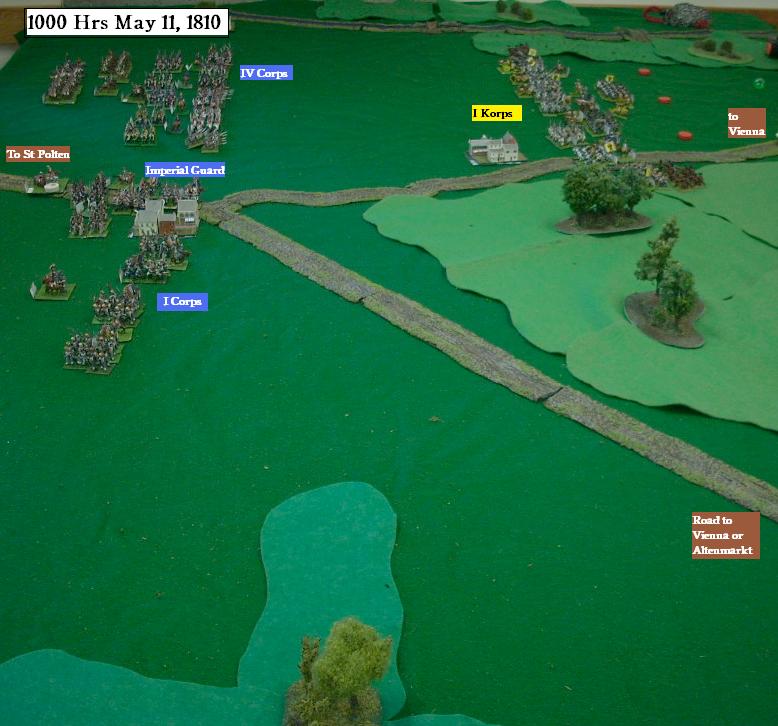
By 1130 hrs, the French plan was evident. The Imperial Guard was
already deep into the Vienna woods and had already sent a large brigade of Jäger
running. The Grenzers would attempt to fall back through the woods before the
Old Guard Grenadiers but their fate would be no better than the Jäger.
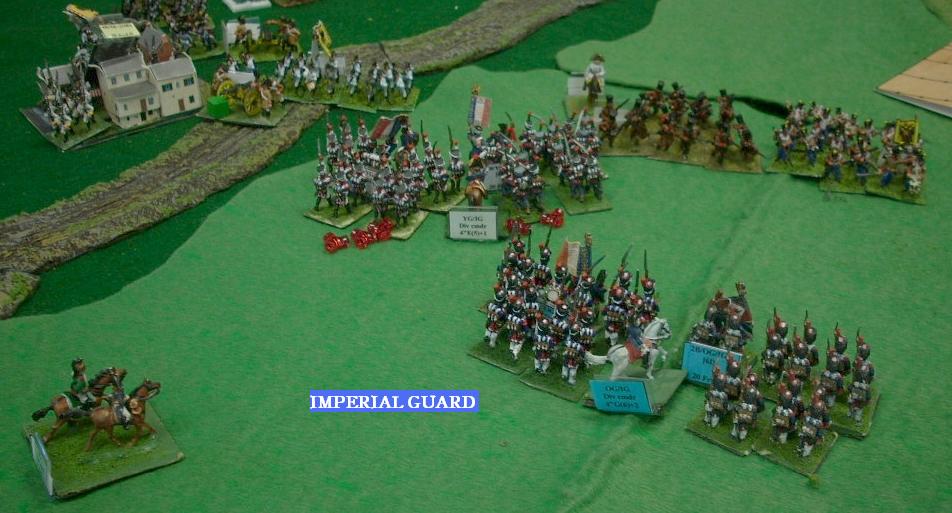
The Austrian artillery in the center, had likewise already sent
some Bavarians routing to the rear. Ney, commander of IV Corps, had pushed the
Bavarians into the center to absorb artillery fire and thereby preserve the
French infantry. By this time, Napoleon had sent couriers to his subordinates
setting 1230 as the time that he wanted all his divisions to be engaged at
musket range and that 1300 hours was the hour appointed for the all-out attack.

Seeing the French plan, Charles has decided to commit his hidden
reserve and the Liebegarde Corps arrives from the southern edge of the Vienna
wood. They are a few hours yet from the French right flank but there is no right
flank and Napoleon has ordered no troops to face this threat. Concentrate on the
attack, his commanders are told.
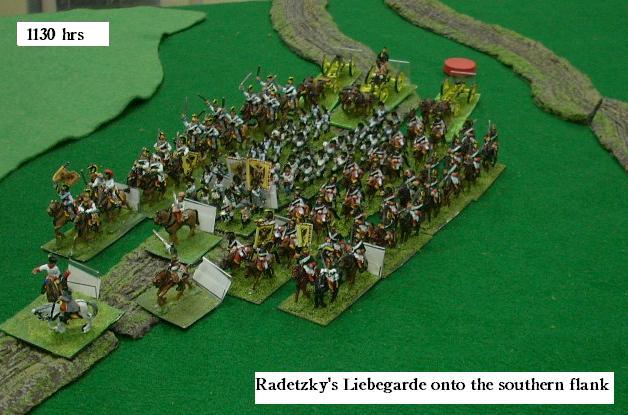
At 1230 hrs, the wood has been cleared of Austrians and the Old
Guard presses forward energetically. Artillery arriving for I Corps and the
Guard, seeing that it will likely have no chance to deploy against Austrian I
Corps, begins to set itself up to face the Liebegarde. As second Bavarian
brigade has been routed by fire and the general for division will miss the
upcoming attack, going back instead to rally. Reports would come out that Ney
was not watching his watch.
Behind Austrian I Korps, the 2nd Provisional Korps is now
visible to the French and also, two divisions of Landwehr cavalry arrive from
Vienna to both support the line but also add to the mass behind it.
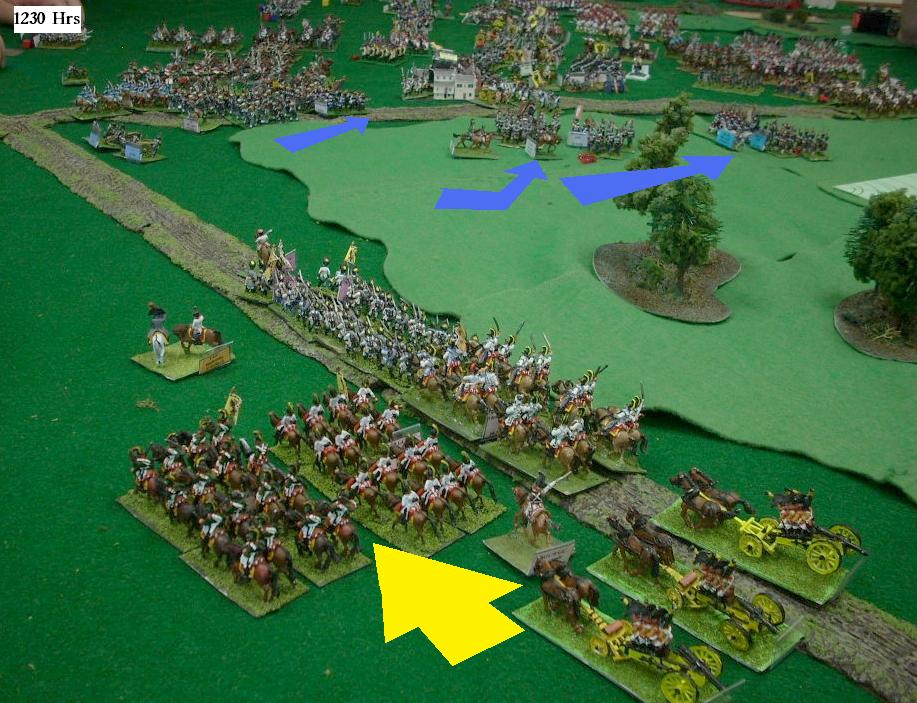
Another view of the center. On the left, Ney has sent in some
cavalry as an opportunity presented itself and Gerard is a bit behind schedule
but generally, the French are appearing to be well set up to launch the prepared
attack.
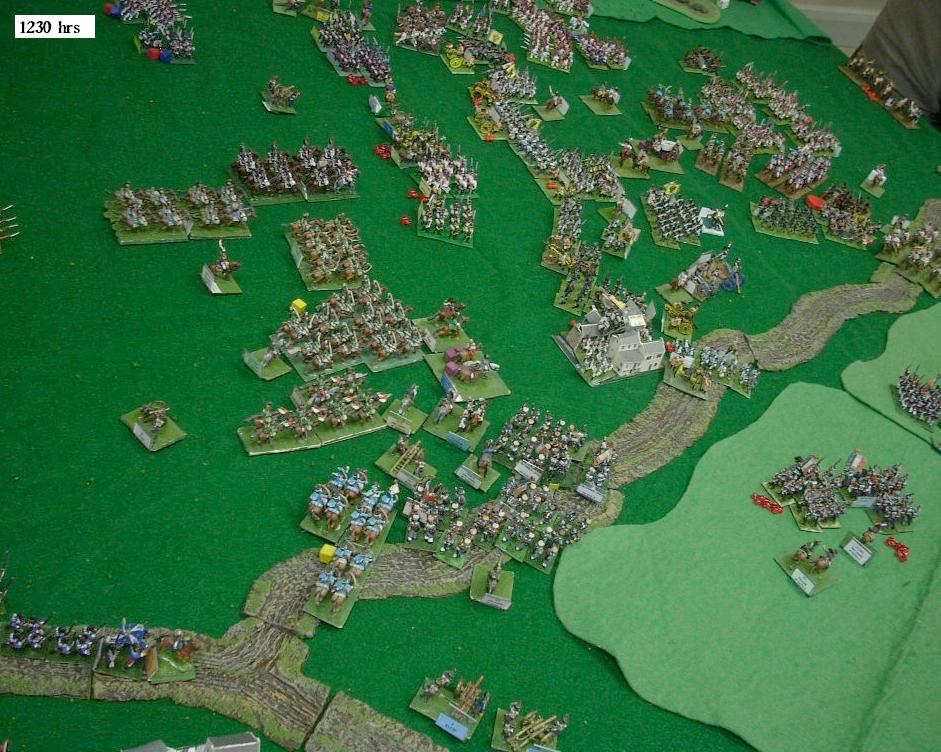
The coordinated, aggressive attack across the front goes off
almost as scheduled. It is only the Bavarians in the center that miss their
timetable.

On the Austrian left, the flank movement by the Imperial Guard
obliges the Austrians to swing three of their batteries about, almost back to
back with those guns firing to the front. This would be the scene of a
miraculous success for the Austrians where an infantry brigade would repulse a
simultaneous attack by French light cavalry and grenadier infantry of the Young
Guard. The grenadiers would be routed and it would be hours before they would
get back into the fight.
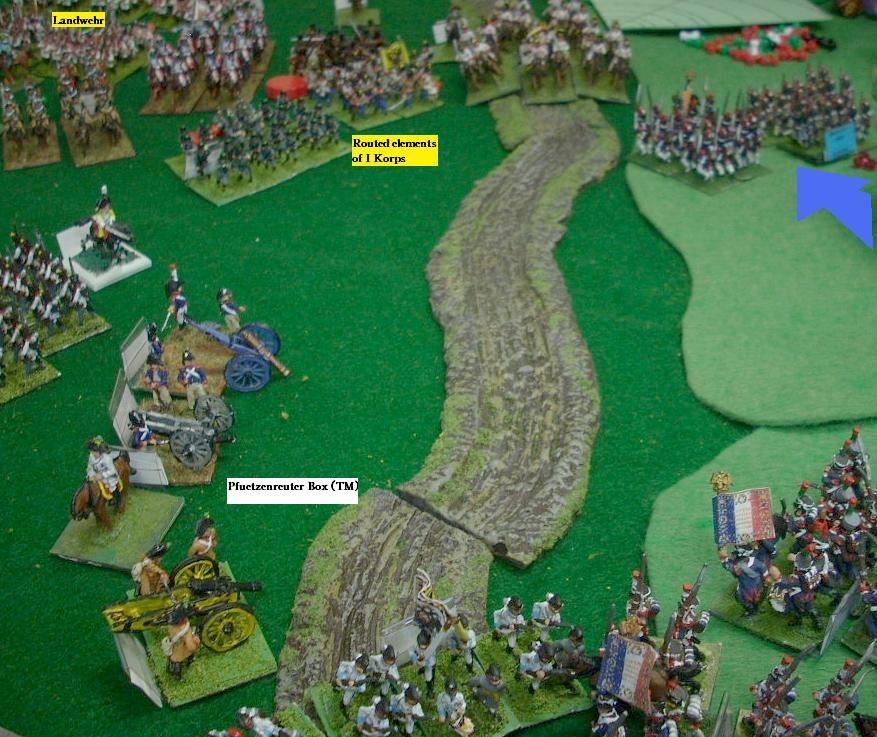
Not every French attack was entirely successful, but overall,
the effect was devastating to the Austrians. Some 50 artillery and five brigades
of infantry are captured or routed.
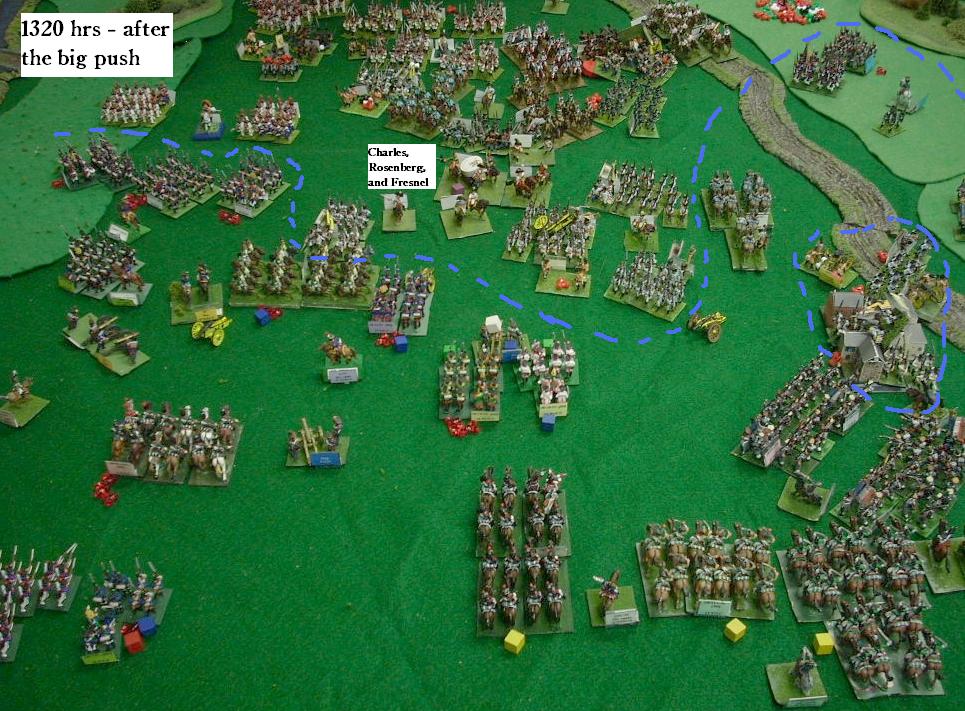
Radetzky, meanwhile, is obliged to deploy his Corps in the face
of a hastily thrown together French blocking force consisting of a Baden
division and the cavalry and artillery of the Imperial Guard.
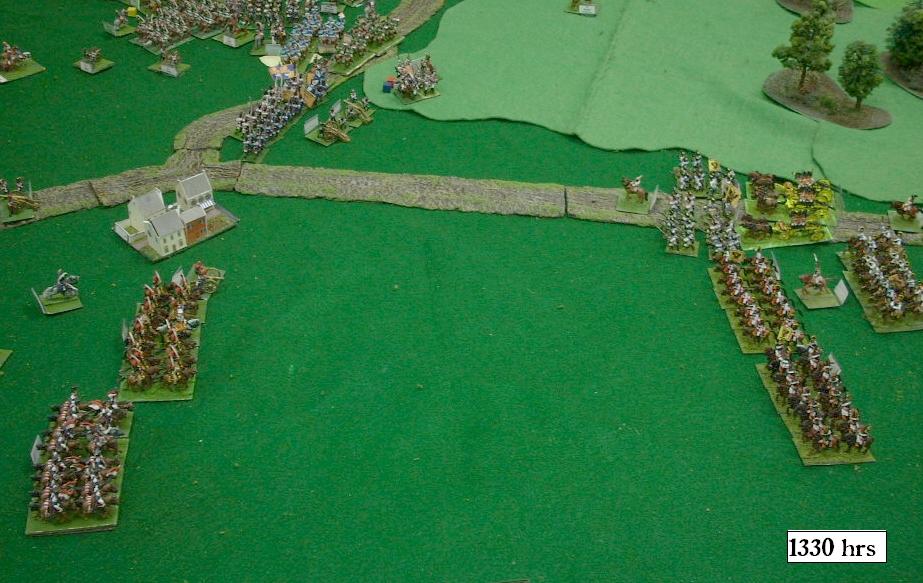
The French attack continues relentlessly forward in the center.
In particular, the Imperial Guard and the 15th Division of IV Corps carve
decisively into the flanks, hurling back everything that the Austrians attempt
to put in their way. I Korps and 2nd Provisional Korps are both broken. Pockets
of troops are left behind the the French advance. Without any orders, they can
only remain in place and fight to defend themselves as best they can.
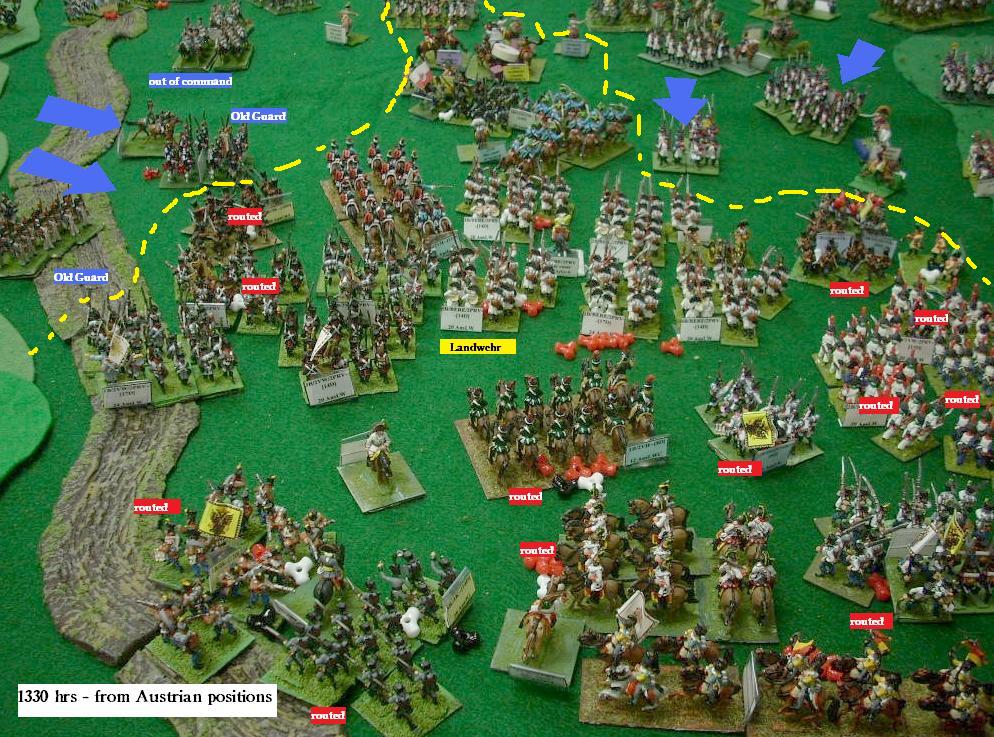
Archduke Charles leaves the center and rides with his small
staff through the woods, past the still broken Young Guard grenadiers. Behind
Charles, his Corps commanders would suffer poorly. Rosenburg would be captured
and Fresnel killed. Two Austrian divisional commanders would also fall.

After little more than an hour, 2 Provisional Korps is routed
from the field, returning broken to Vienna. I Korps and the Landwehr cavalry
clings to the edge of the woods and tries to rally as the French attack moves
past them. Napoleon though is furious at Pajol, the commander of 1st Cavalry
Corps. He has not followed up the attack. He has missed an opportunity for
glorious pursuit, and is instead distracted by the Austrian Liebegarde and
begins to shift his divisions to the right. Similarly, Gerard's I Korps gets
bogged down trying to solve the problem of a few isolated Austrian infantry
brigades and does not pursue as aggressively as the French Emperor would wish.

Radetzky opens his attack up with two Grenadier brigades against
the artillery of I Corps and the Baden infantry, along with 1st Cavalry Corps
cavalry, counter attack to give them pause. The command of the Guard cavalry
suffers with their corps commander several miles away leading the grenadiers in
their pursuit of I Korps.
Not long after this, the Austrian heavy cavalry and French Guard
Cavalry would meet in a desperate cavalry melee and both sides would fall back
with heavy losses. The second wave of the Austrian attack would overrun the
Guard horse artillery but leave it vulnerable to a counter-attack by fresh
cavalry from the French 1st Cavalry Corps.
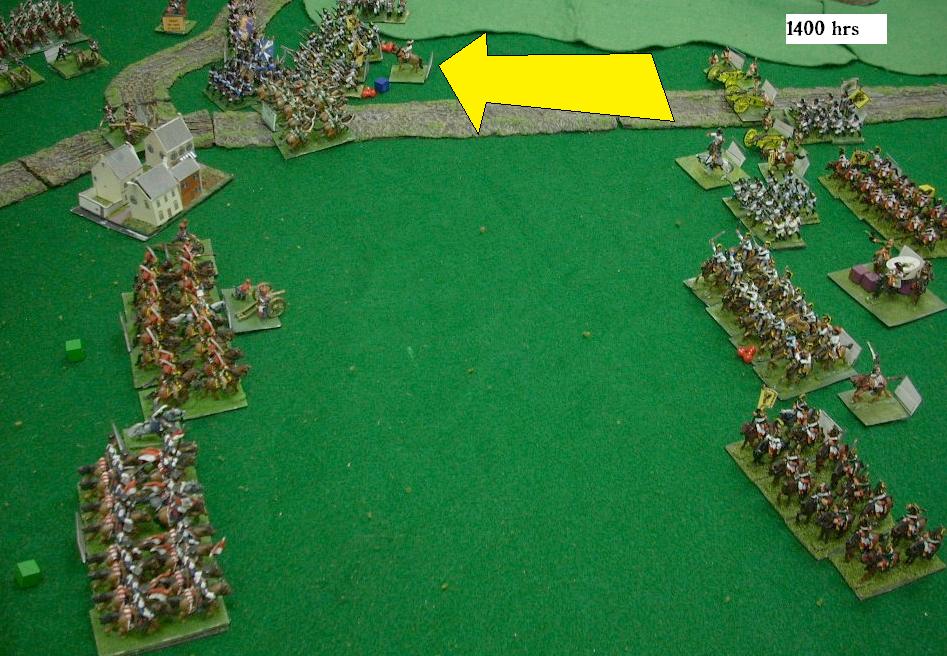
The Guard, along with the cavalry and one division of IV Corps
continue to attack but Austrian I Korps has found opportunity to make some
important rallies. They collect themselves and, despite sever command problems,
try to organize a defense. A lot of Jager and Grenzer fire is poured into the
Grenadiers but at that point the skies opened up with such a torrent of rains
that the fighting had to be ended for the day.
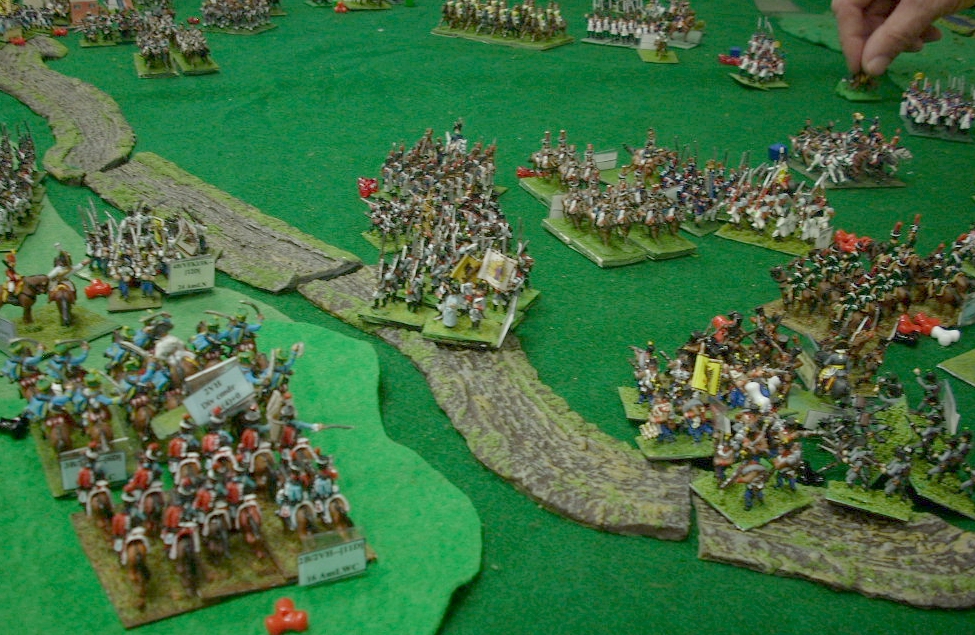
Neither side would retreat. When the battle resumed the
following day (automated), the Austrian army retreated badly damaged to Vienna.
Napoleon's army was too damaged to dare pursuing to the capital.


 On May 9th, Napoleon drove back a tentative attack by Austrian 2nd Provisional
Korps at St Polten. On the 10th, the forefront of the army pressed forward to
Purkersoors, seeking to continue the impetus against the Austrian capital. After
40 days of campaigning, the French army is much reduced and the army that
marches out to meet them at Purkersoors is fresh and well-equipped. It is the
army that Charles has rapidly assembled after the surrender at Steyr.
Unfortunately for the Austrians, their haste in mustering this army has required
that the force be predominantly conscripts.
On May 9th, Napoleon drove back a tentative attack by Austrian 2nd Provisional
Korps at St Polten. On the 10th, the forefront of the army pressed forward to
Purkersoors, seeking to continue the impetus against the Austrian capital. After
40 days of campaigning, the French army is much reduced and the army that
marches out to meet them at Purkersoors is fresh and well-equipped. It is the
army that Charles has rapidly assembled after the surrender at Steyr.
Unfortunately for the Austrians, their haste in mustering this army has required
that the force be predominantly conscripts. 














